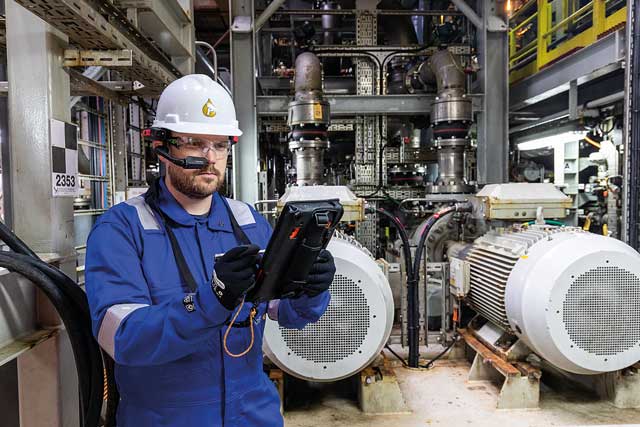
Digitalising maintenance, using a connected worker approach with access to remote assistance from experts, has transformed productivity in offshore inspections says Steve Johnson, vice president of digital for Petrofac’s Engineering and Production Services Business.

In recent years, successive downturns in the oil and gas service sector began to drive a shift in approach across the supply chain. There was a need to challenge convention, to innovate, improve, and stay ahead. This required international service provider to the energy industry Petrofac to find new ways of achieving efficiency and consistency by eradicating nonproductive and non-value-adding activities.
The company set out a bold ambition for what it thought it could achieve with digital technology. Building a “Connected Worker” toolkit, underpinned by over the shoulder support, in which offshore workers could be remotely assisted by subject matter experts via mobile devices, was one of the strategic initiatives identified for implementation. In this instance, the specific aim was to significantly improve the processes surrounding traditional inspection and maintenance, through digitalisation.
First, wearable technology was identified that would empower the company’s teams to work faster, to be more agile and efficient and ultimately support North Sea clients in significantly increasing productivity.
Then the team engaged technology providers and the wider industry to find real examples where the concept of the connected worker had successfully been adopted in other sectors. This ranged from the remote connection of maintenance technicians working on dispersed telecommunication sites across Europe with experts to support the correct maintenance of old non-standard equipment, to significant productivity improvements through the use of digitalised work processes in the aerospace sector.
Using a combination of over the shoulder support, digital twin technology, and the company’s proprietary software, BuildME, Petrofac worked to digitalise all forms of maintenance and inspection activity. From planning, through execution and reporting, the Connected Worker toolkit quickly proved to achieve significant productivity gains compared with normal industry standards.
Across more than 1,500 North Sea inspections, it has driven a 200% increase in productivity compared with the industry norm.
Connected Worker has wide-ranging applicability. Its digital workflow capability enhances productivity by enabling work procedures and supporting information to be made available to offshore teams on mobile devices in a user-friendly, step-by-step form. Application of over the shoulder support has allowed the resolution of problems to be speeded up.
In one example the company was able to help one client with its export gas compressor by linking the team in the field with its rotating machinery subject matter expert. This resulted in a faster diagnosis of the problem and speedier resolution, saving days of downtime and lost production worth more than several hundred thousand pounds of revenue for our client.
Not only has the technology helped clients achieve significant efficiency gains, it has also helped to reduce the number of people on board an asset at any one time by enabling offshore teams to seamlessly connect, through hands-free video calls, to office-based experts, reducing the need to send technical support offshore. This has brought further cost savings for clients, as well as guaranteeing that adequate social distancing measures can be maintained during the current coronavirus pandemic, while also helping to reduce carbon emissions.
Utilising wearable technologies and BuildME software, Petrofac was commissioned by an industry body to remove the manual, paper-based and time-consuming processes surrounding its traditional technical trade tests, which ensure the critical skills of craftspeople and technicians match the demands of industry. Known as the Connected Competency model, these tests can now be carried out digitally, removing the need for an individual to attend a training centre by enabling any offshore worker to take the place of an assessor. Either a tablet or headset can be used to gather all necessary evidence and appropriate information, such as photos, videos and comments, in the correct format for an assessment.
The benefits of over the shoulder support and training are endless. Important safety messages are reinforced through the step-by-step workflows, which in turn ensure that processes are followed correctly, reducing the risk of injury and lost time incidents. Automated reporting is also enhancing the quality of data we receive, allowing teams to identify issues and solutions while still onshore, thus reducing the workload for the person offshore.
Through Connected Worker and Connected Competency, Petrofac is building a data trail that reduces the amount of quality control required and instead provides more quality assurance for clients. Faced with the task of future-proofing our industry, digital technology is most certainly the answer – Petrofac is already proving that it can drive huge value.
www.petrofac.com
To find out how Petrofac can provide support contact
Keith.Scott@petrofac.com

